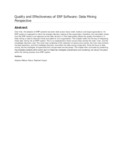| dc.contributor.author | Mutua, Stephen Makau | |
| dc.contributor.author | l Angulu, Raphae | |
| dc.date.accessioned | 2021-06-22T13:50:08Z | |
| dc.date.available | 2021-06-22T13:50:08Z | |
| dc.date.issued | 2020-05 | |
| dc.identifier.uri | https://doi.org/10.4018/978-1-5225-7678-5.ch002 | |
| dc.identifier.uri | https://www.igi-global.com/chapter/quality-and-effectiveness-of-erp-software/232348 | |
| dc.identifier.uri | http://r-library.mmust.ac.ke/123456789/1715 | |
| dc.description.abstract | Over time, the adoption of ERP systems has been wide across many small, medium, and large organizations. An ERP system is supposed to inform the strategic decision making of the organization; therefore, the information drawn from the ERP system is as important as the data stored in it. Poor data quality affects the quality information in it. Data mining is used to discover trends and patterns of an organization. This chapter looks into the way of integrating these data mining into an ERP system. This is conceptualized in three crucial views namely the outer, inner, and the knowledge discovery view. The outer view comprises of the collection of various entry points, the inner view contains the data repository, and the knowledge discovery view offers the data mining component. Since the focus is data mining, the two strategies of supervised and unsupervised are discussed. The chapter then concludes by presenting the probable problems within which each of these two strategies (classification and clustering) can be put into place within the mining process of an ERP system. | en_US |
| dc.language.iso | en | en_US |
| dc.publisher | Journal of Global Information Management | en_US |
| dc.subject | Quality , Effectiveness ,ERP, Software, Data, Mining, Perspective | en_US |
| dc.title | Quality and Effectiveness of ERP Software: Data Mining Perspective | en_US |
| dc.type | Article | en_US |

